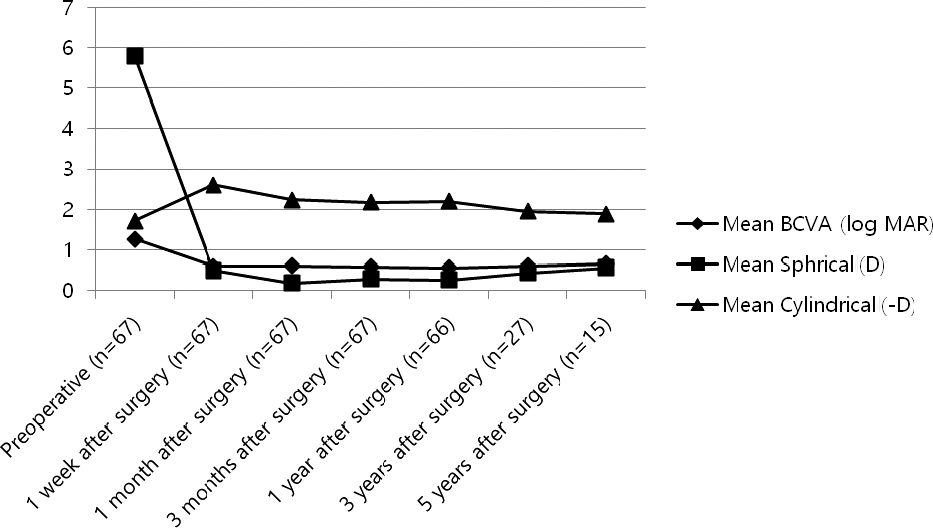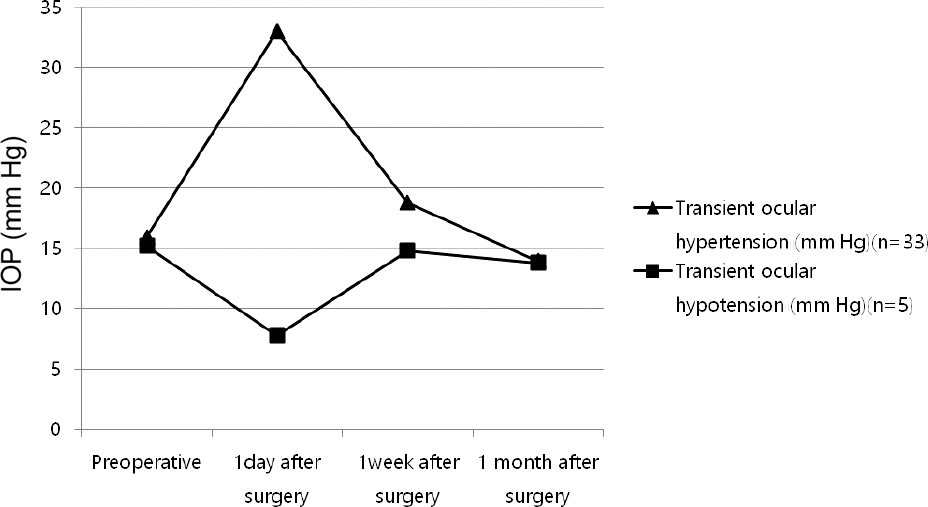J Korean Ophthalmol Soc.
2016 Jan;57(1):43-49. 10.3341/jkos.2016.57.1.43.
Long-Term Results of Transscleral Fixation of Posterior Chamber Intraocular Lens
- Affiliations
-
- 1Department of Ophthalmology, Bucheon Hospital, Soonchunhyang University College of Medicine, Bucheon, Korea. yhohn@schmc.ac.kr
- KMID: 2213836
- DOI: http://doi.org/10.3341/jkos.2016.57.1.43
Abstract
- PURPOSE
To investigate the long-term results of transscleral fixation of posterior chamber intraocular lens (IOL) for unstable posterior capsular supporting structure.
METHODS
We performed a retrospective review of 67 patients (67 eyes) with unstable posterior capsular supporting structure who underwent transscleral fixation at Soonchunhyang University Bucheon Hospital from March 2005 to January 2013. Transscleral fixation without scleral flap was performed by a single surgeon. We analyzed the causes of transscleral fixation and compared postoperative best-corrected visual acuity (BCVA) and spherical diopter.
RESULTS
Among the 67 eyes of 67 patients, the causes of transscleral fixation included IOL subluxation (33 cases, 49.2%), IOL dislocation (11 cases, 16.4%), intraoperative posterior capsule rupture (8 cases, 11.9%), aphakia associated with previous intraocular surgery (7 cases, 10.4%), crystalline lens disorder with zonular dialysis (4 cases, 5.9%) and IOL opacity (4 cases, 5.9%). The mean BCVA before surgery was 1.26 +/- 0.94 (log MAR) and the visual acuity improved to 0.59 +/- 0.71, 0.60 +/- 0.69, 0.58 +/- 0.70, 0.55 +/- 0.70, 0.60 +/- 0.58 and 0.66 +/- 0.70 (1 week, 1 month, 3 months, 1 year, 3 years and 5 years, respectively, after the surgery; p < 0.05).
CONCLUSIONS
Posterior chamber IOL transscleral fixation in unstable posterior capsular supporting structure is effective for increasing visual acuity and spherical diopter. Specifically, the most improvement was observed at one month after surgery. Transscleral fixation is an adequate surgical procedure for fast improvement of visual acuity with long-term effects.
Keyword
MeSH Terms
Figure
Reference
-
References
1. Malbran ES, Malbran E Jr, Negri I. Lens guide suture for transport and fixation in secondary IOL implantation after intracapsular extraction. Int Ophthalmol. 1986; 9:151–60.
Article2. Holt DG, Young J, Stagg B, Ambati BK. Anterior chamber intra-ocular lens, sutured posterior chamber intraocular lens, or glued in-traocular lens: where do we stand? Curr Opin Ophthalmol 2012; 23. 62–7.3. Hannush SB. Sutured posterior chamber intraocular lenses: in-dications and procedure. Curr Opin Ophthalmol. 2000; 11:233–40.
Article4. Hu BV, Shin DH, Gibbs KA, Hong YJ. Implantation of posterior chamber lens in the absence of capsular and zonular support. Arch Ophthalmol. 1988; 106:416–20.
Article5. Lewis JS. Ab externo sulcus fixation. Ophthalmic Surg 1991; 22. 692–5.
Article6. Stark WJ, Goodman G, Goodman D, Gottsch J. Posterior chamber intraocular lens implantation in the absence of posterior capsular support. Ophthalmic Surg. 1988; 19:240–3.
Article7. Güell JL, Barrera A, Manero F. A review of suturing techniques for posterior chamber lenses. Curr Opin Ophthalmol. 2004; 15:44–50.8. Yang JY, Chu YK. Modified surgical technique for transscleral fix-ation of a single-piece acrylic intraocular lens in the absence of capsular support. J Korean Ophthalmol Soc. 2012; 53:1794–800.
Article9. Jung MO, Koh JW. Clinical results of modified Ab Externo and one-knot technique. J Korean Ophthalmol Soc. 2012; 53:1783–8.
Article10. Ma DJ, Kim MK, Wee WR. Knotless external fixation technique for posterior chamber intraocular lens transscleral fixation: a 5-case analysis. J Korean Ophthalmol Soc. 2012; 53:1609–14.
Article11. Duffey RJ, Holland EJ, Agapitos PJ, Lindstrom RL. Anatomic study of transsclerally sutured intraocular lens implantation. Am J Ophthalmol. 1989; 108:300–9.
Article12. Smiddy WE, Sawusch MR, O'Brien TP, et al. Implantation of scler-al-fixated posterior chamber intraocular lenses. J Cataract Refract Surg. 1990; 16:691–6.
Article13. Kokame GT, Yamamoto I, Mandel H. Scleral fixation of dislocated posterior chamber intraocular lenses: temporary haptic external-ization through a clear corneal incision. J Cataract Refract Surg. 2004; 30:1049–56.14. Shin JH, Lee JE, Oum BS. Clinical outcomes of the surgical man-agement with dislocated posterior chamber intraocular lens. J Korean Ophthalmol Soc. 2012; 53:420–7.
Article15. Hayashi K, Hirata A, Hayashi H. Possible predisposing factors for in-the-bag and out-of-the-bag intraocular lens dislocation and out-comes of intraocular lens exchange surgery. Ophthalmology. 2007; 114:969–75.
Article16. Michaeli A, Assia EI. Scleral and iris fixation of posterior chamber lenses in the absence of capsular support. Curr Opin Ophthalmol. 2005; 16:57–60.
Article17. Por YM, Lavin MJ. Techniques of intraocular lens suspension in the absence of capsular/zonular support. Surv Ophthalmol. 2005; 50:429–62.
Article18. Wagoner MD, Cox TA, Ariyasu RG. . Intraocular lens im-plantation in the absence of capsular support: a report by the American Academy of Ophthalmology. Ophthalmology. 2003; 110:840–59.19. Heilskov T, Joondeph BC, Olsen KR, Blankenship GW. Late en-dophthalmitis after transscleral fixation of a posterior chamber in-traocular lens. Arch Ophthalmol. 1989; 107:1427.
Article20. Lewis JS. Sulcus fixation without flaps. Ophthalmology. 1993; 100:1346–50.
Article21. Baykara M, Avci R. Prevention of suture knot exposure in posterior chamber intraocular lens implantation by 4-point scleral fixation technique. Ophthalmic Surg Lasers Imaging. 2004; 35:379–82.
Article22. Hoffman RS, Fine IH, Packer M. Scleral fixation without con-junctival dissection. J Cataract Refract Surg. 2006; 32:1907–12.
Article23. Szurman P, Petermeier K, Aisenbrey S. . Z-suture: a new knot-less technique for transscleral suture fixation of intraocular implants. Br J Ophthalmol. 2010; 94:167–9.
Article24. Asadi R, Kheirkhah A. Long-term results of scleral fixation of pos-terior chamber intraocular lenses in children. Ophthalmology. 2008; 115:67–72.
Article25. Vote BJ, Tranos P, Bunce C. . Long-term outcome of combined pars plana vitrectomy and scleral fixated sutured posterior chamber intraocular lens implantation. Am J Ophthalmol. 2006; 141:308–12.
Article
- Full Text Links
- Actions
-
Cited
- CITED
-
- Close
- Share
- Similar articles
-
- Implantation of Posterior Chamber Intraocular Lens by Transscleral Suture Fixation: Long-term Results
- Knotless External Fixation Technique for Posterior Chamber Intraocular Lens Transscleral Fixation: A 5-Case Analysis
- Effect of Distances Between Corneoscleral Limbus and Transscleral Sutures on Vision and Refraction in Eyes with Posterior Chamber Intraocular Lens Implanted by Transscleral Suture Fixation
- Long-term results of implantation of posterior chamber intraocular lens by suture fixation
- An Anatomical Study on Transscleral Suture fixation of Posterior Chamber Intraocular Lens





